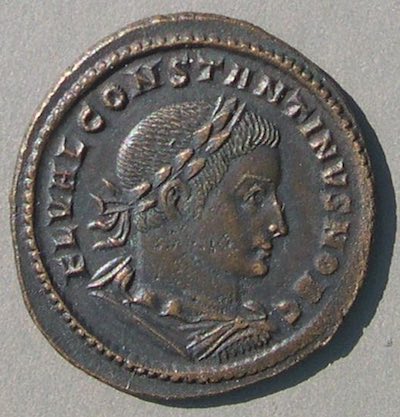
July 306-July 307, at his main mint, Trier.
 |
| Constantine, struck as Caesar, July 306-July 307, at his main mint, Trier. |
Coins of the Roman rulers, July 306 to autumn, 324
This is one web page of many on Roman coins from 284-324. There is a page of links to all the topic pages. This page is about Roman coins after the Second Tetrarchy, from 306-324.
The Second Tetrarchy ended with the natural death of Constantius, western Augustus, in July 306. His son, Constantine, was acclaimed emperor by his army. A power struggle ensued which involved seven rulers and ended in 324 with one, Constantine, as sole Augustus.
Table of Contents:
The seven major emperors (next)
Other Romans on coins.
Coins of each of the seven.
Notes for collectors on frequencies.
Coins of the lesser Romans.
Commemoratives.
History. The sequence of events that affect the coins.
Issues and how they illuminate the power structure.
(Click on the obverse image to see both sides of the coin and its identification.)
What's new? 2021, Feb. 4: A "third reign" coin of Maximian from after the Confernce at Carnuntum.
2020, June 6: A "VLPP" coin of 319-- a new denomination for Constantine.
May 31: Coin of Maxentius which emphsizes the city of Rome.
May 27: Links to improve navigation have been added, with more comments on related history.
May 17: Coins of Constantine with Sol, Licinius with Jupiter, and Maxentius with elephants.
The seven competing rulers and their titles in this time period are:
• Constantine, son of Constantius. He had coins as Caesar (top right) and Augustus. Galerius issued coins in his name with the unusual title FIL AVGG. (Here)
• Galerius had been eastern Caesar 293-305 under the First Tetrarchy and eastern Augustus during the Second Tetrarchy. After July 306 he had coins as Augustus until his death in 311. (Here)
• Maximinus II had been eastern Caesar under the Second Tetrarchy, 305-306. After July 306 he continued to have coins as Caesar and he had coins as Augustus from 310 until his death in 313. Galerius issued coins in his name with the unusual title FIL AVGG (Here). There was also a small anonymous series.
• Severus II had been western Caesar under the Second Tetrarchy, 305-306. After July 306 he had coins as western Augustus until he was defeated in Spring 307 by Maxentius. (Here)
• Maxentius was the son of the western Augustus Maximian who retired in 305. Maxentius usurped power in Rome October 28, 306. He had very rare coins as PRINC INVICT and as Caesar, only at Carthage. He had coins as Augustus from 306 until his death at the Battle of the Milvian Bridge against Constantine, Oct. 28, 312. (Here)
• Maximian, Augustus during the First Tetrarchy, 293-305, came out of retirement to join with Maxentius and had "second reign" coins as Augustus, 306-308. Most of his very common coins are from his "first reign," which is earlier than the time period of this page. (Below, here) (Here is a page with much more about his second-reign coins.)
• Licinius was appointed at the Conference at Carnuntum as the new western Augustus, November, 308. He had coins as Augustus. 308-324. (Here)
This page addresses only AE coins, not gold and silver.
History. The sequence of events that affected the coinage is far below on this page.
Others Romans on Coins. Also, coins were minted in the names of a few lesser characters:
Galeria Valeria (here), wife of Galerius and daughter of Diocletian, m. 293, d. c. 315. She had coins struck in her name c. Dec. 308 - May 311.
Crispus (here) and Constantine II (here), sons of Constantine, and Licinius II (here), son of Licinius, were all made Caesars in 317 by agreement of Constantine and Licinius.
Romulus (here), son of Maxentius, was born about 306 and died in 309 as a young child (during his second consulship!). All his coins are commemorative.
Alexander of Carthage rebelled against Maxentius at Carthage, 311. His coins are very rare.
Valerius Valens was appointed co-emperor by Licinius in autumn 316, to help in the first Civil War against Constantine. He was executed as part of the truce agreement in early 317 which ended the war. His coins are extremely rare.
Martinian was appointed co-emperor by Licinius in 324 to help in the second Civil War against Constantine. His coins are extremely rare.
Commemoratives. Some scarce commemorative coins were minted:
Constantius as DIVO by Constantine.
Romulus, son of Maxentius. Coins as DIVO by Maxentius.
Maximian, Constantius, and Galerius as DIVO by Maxentius.
Galerius as DIVO by Maximinus II as FIL AVG and as DIVO by Licinius.
Two of those commemorative types from the period 306 to 324 are illustrated below and all of them are discussed on the page "Commemorative Coins of 306-324."
Events. The time period for this page begins in July 306 with Constantine's acclamation as emperor. By the end of 313, when Maximinus II died, only Constantine and Licinus were left standing. They had two civil wars. The first in 316-317 ended with a truce after Constantine gained territory. In 317 they agreed to make their three sons Caesars and each minted for the other. However, in 324 they had a second civil war which ended with the defeat of the Licinii and their execution shortly thereafter. Then Constantine was sole Augustus, the event which ends the time period discussed on this page. (For much more abut the events that affect coins, see below.)
Note for collectors. Coins of each of the seven main rulers are common, as are coins of Galeria Valeria, Crispus, Constantine II, and Licinius II. The commemorative issues are all scarce or rare. It is quite possible, and not expensive, to get an attractive collection of all the rulers except Alexander, Valens, and Martinian. For more about the frequencies of the coins, see below.
This page does not illustrate all the types. Unlike the First Tetrarchy and the Second Tetrarchy, each of which had a small number of follis types which were all illustrated on their pages, the period 306 to 324 has very many follis types--far too many to illustrate them all. For example, Failmezger lists 170 AE types for Constantine and 48 for Maxentius.
The seven main emperors:
Constantine is key to the beginning and the end of this period from July 306 to 324. His elevation to emperor upon the death of his father in July 306 and the usurpation of power in Rome by Maxentius in October 306 violated the orderly tetrarchal succession rules and initiated this period of conflict. After many events (outlined below) that affected who was in power where, his defeat of Licinius in 324 left him the sole Augustus. The coinage of Constantine consists of well over 150 types and is far too complex to discuss throughly here, but the next five coins illustrate important changes.
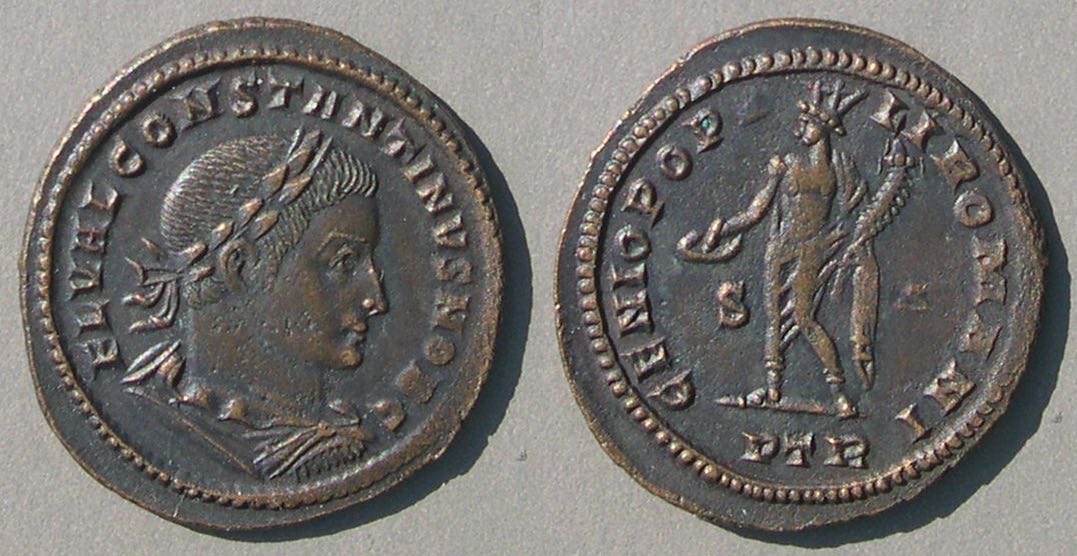
Constantine as Caesar, July 306 - July 307
29-28 mm.
Struck c. Spring 307.
FL VAL CONSTANTINVS NOB C
(FLavius VALerius) A young portrait.
GENIO POPVLI ROMANI
Genius standing left, loins draped, holding patera and cornucopia.
S A
PTR
RIC VI Trier 694 "Spring 307"
In 307 Constantine, with the support of Maximian, took the title Augustus after the previous western Augustus, Severus II, was defeated and killed by Maxentius. He was Caesar who, by the system, would be promoted to Augustus when the previous Augustus died. Maximian, who had had the title of Augustus, had the authority to award it.
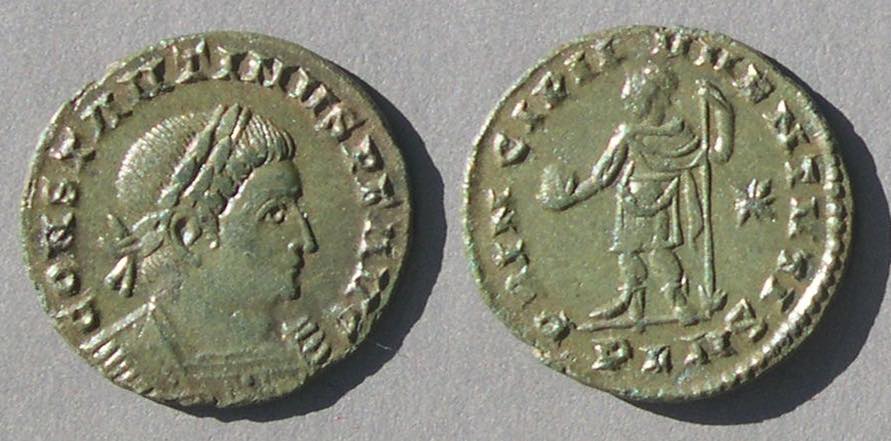 Constantine, struck mid 310 - late 312, as Augustus
Constantine, struck mid 310 - late 312, as Augustus
at London
22-21 mm. 4.16 grams.
CONSTANTINVS PF AVG
PRINCIPI IVVENTVTIS
"Prince of youth," previously a title given to young heirs.
*
PLN
RIC VI London 215.
Lovely even green patina.
 Constantine, as FIL AVG
Constantine, as FIL AVG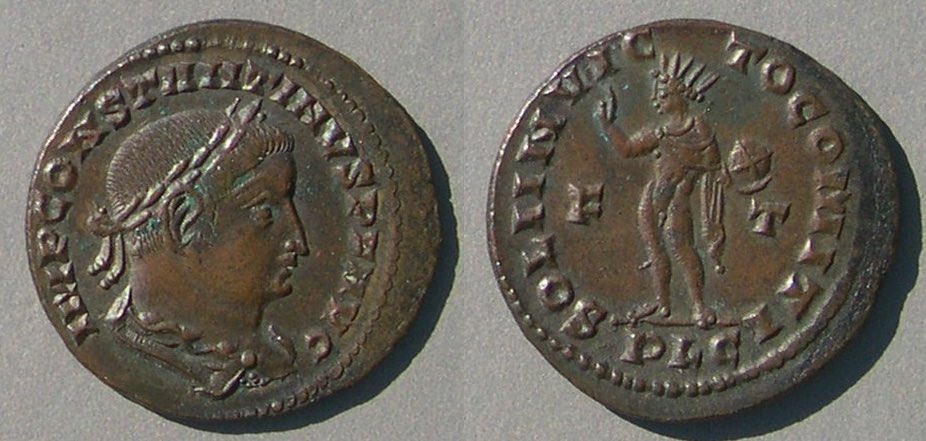 Constantine, 307-337
Constantine, 307-337 Constantine, 307-337
Constantine, 307-337Galerius was made eastern Caesar of the First Tetrarchy in 293. Upon the retirement of Diocletian in 305 he became eastern Augustus of the Second Tetrarchy and he remained Augustus until his death in 311. All of his coins as Caesar (under the First Tetrarchy) and some of his coins as Augustus (those under the Second Tetrarchy) are from earlier than the time period of this page.
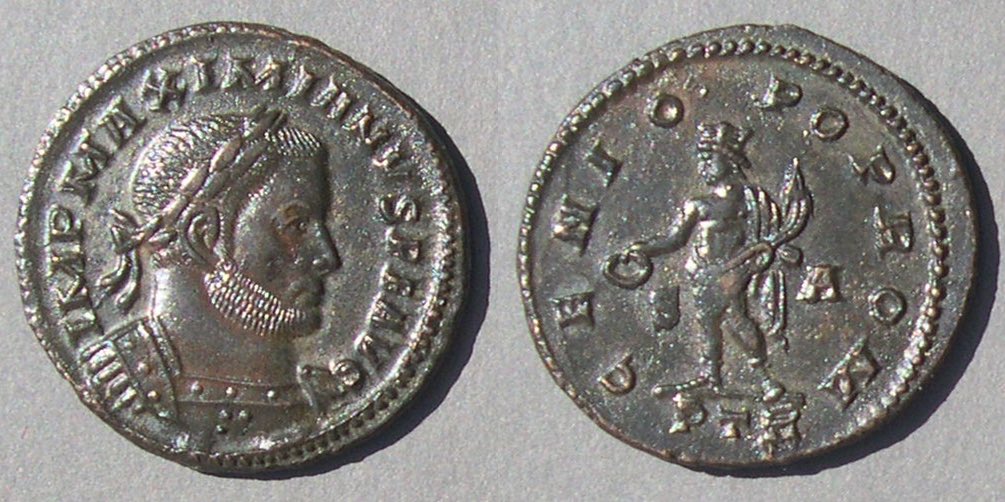 Galerius, as Augustus.
Galerius, as Augustus.
26 mm. 6.63 grams.
MP MAXIMIANVS PF AVG
GENIO POP ROM
S A across field
PTR in exergue
RIC VI Trier 714. "c. summer 307". This group is shared with Constantine as Caesar, Maximinus II as Caesar, and, according to RIC, half-folles of Maximian with this exact same legend! The portrait looks like Galerius rather than Maximian and it is from Trier, apparently before Maximian began his second reign. RIC and I both attribute it to Galerius.
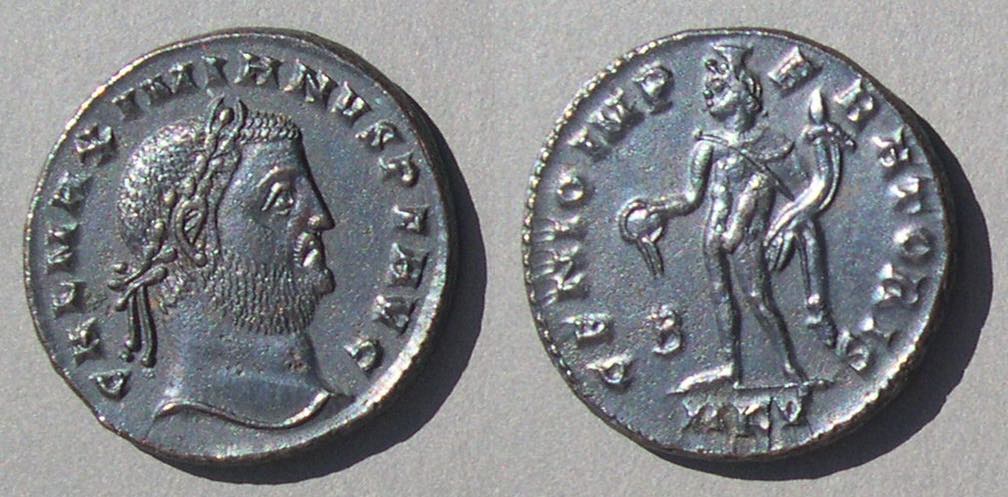 Galerius, as Augustus.
Galerius, as Augustus.Maximinus II was eastern Caesar of the Second Tetrarchy and remained Caesar until after the Conference at Carnuntum in late 308. He wanted to be promoted to Augustus, but Galerius was still Augustus in the east. The Conference decided that Constantine should be demoted from Augustus back to Caesar, which Constantine did not accept. To mollify both of them, Galerius offered the new title FIL AVGG (sons of the Augusti) and minted for both of them with that title. Maximinus II did not accept that title and remained Caesar at his own mints until Maximinus II had his army promote him to Augustus in 310 (His coins as FIL AVG are from mints of Galerius).
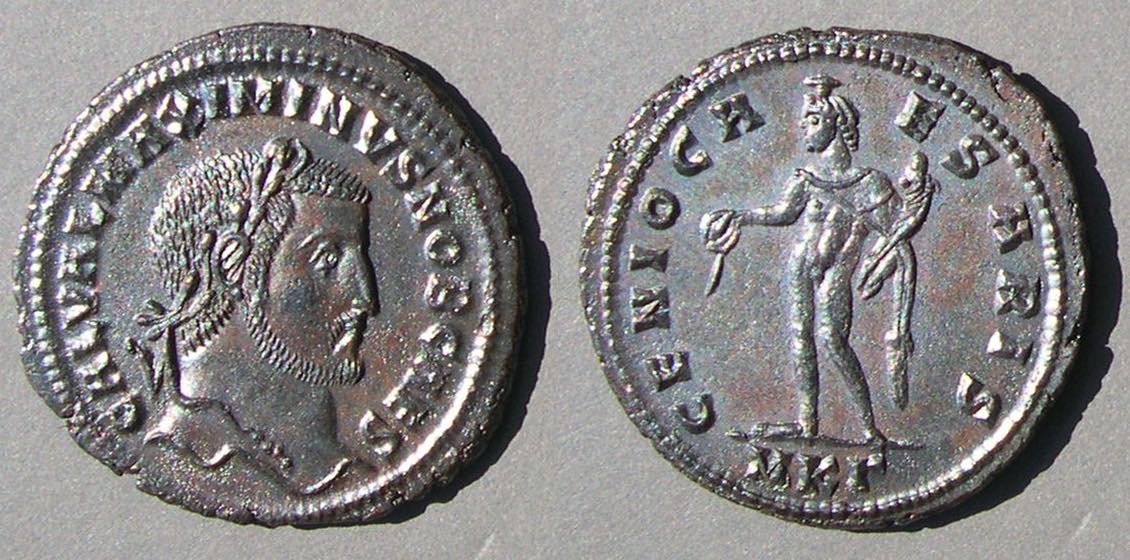 Maximinus II as Caesar.
Maximinus II as Caesar.
27 mm.
Struck c. 308 by Galerius at Cyzicus for Maximinus II.
GAL VAL MAXIMINVS NOB CAES
 Maximinus II as FIL AVGG
Maximinus II as FIL AVGG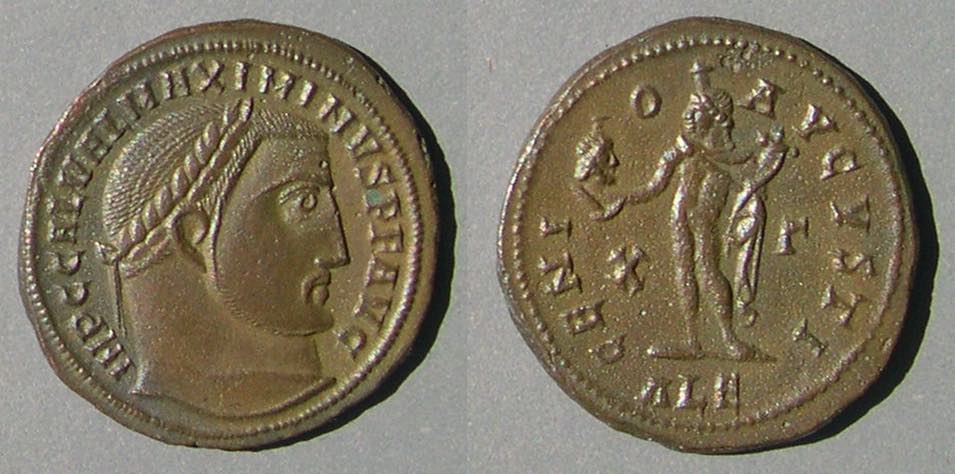 Maximinus II, Caesar 305-310 and Augustus 310-313
Maximinus II, Caesar 305-310 and Augustus 310-313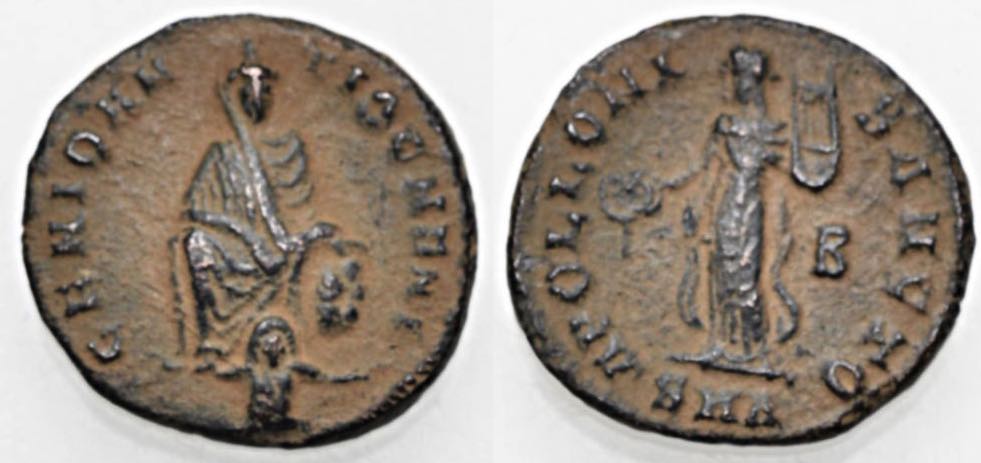
16-15 mm.
GENIO AN-TIOCNENI, Antioch seated facing, river god swimming below
APOLLONI-SANCTO, Apollo holding patera and lyre
B for the second officina) in the right field. SMA in exergue (Sacra Moneta Antioch).
Vagi 2954. van Heesch, type 3, plate 11.3. (96 examples)
Not in RIC, but common anyway.
For much more about this series, see the page "Anonymous civic issues under Maximinus II (AD 310-313)"Severus II was western Caesar under the Second Tetrarchy and assumed the title of western Augustus when Constantius died in July 306. His territory included Rome. When Severus was in the north Maxentius usurped power in Rome. When Severus tried to take Rome back he was defeated in Spring 307. Coins of Severus from after the Second Tetrarchy have him as Augustus. They are less common than his coins as Caesar during the Second Tetrarchy.
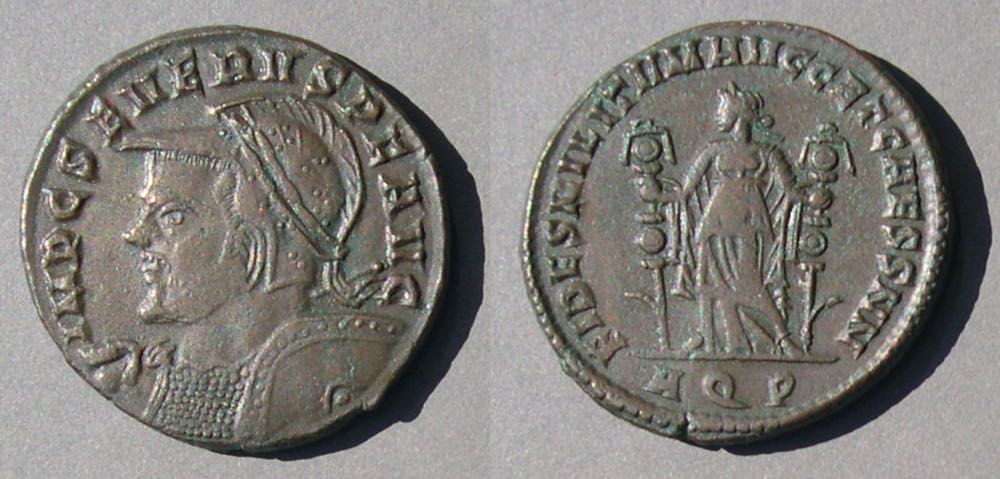 Severus II as Augustus, July 306-Spring 307.
Severus II as Augustus, July 306-Spring 307.Maxentius was the adult son of Maximian, western Augustus of the First Tetrarchy. One of the amazing distinctions of the tetrarchal system was that is did not automatically promote sons of the current rulers. By the standards of most ages, Maxentius would have become Caesar when Maximian was forced to retire in 305. However, Diocletian thought Maxentius unfit and realized that if he (Diocletian) were to support Constantine as Caesar under Constantius it would be impolitic to not promote Maxentius, so both were passed over in favor of new men who became Caesars for the Second Tetrarchy (Severus II in the west and Maximinus II in the east, both supported by Galerius). In 306 when Constantius died Severus II became Augustus in the west (and Constantine became Caesar). When Severus II was absent from Rome it didn't take long for Maxentius to rally the troops at Rome and assume power. There are very rare coins of his from Carthage that give him the title PRINC INVICT and then very rare coins that give him the title Caesar. However, almost all of his coins have the title Augustus.
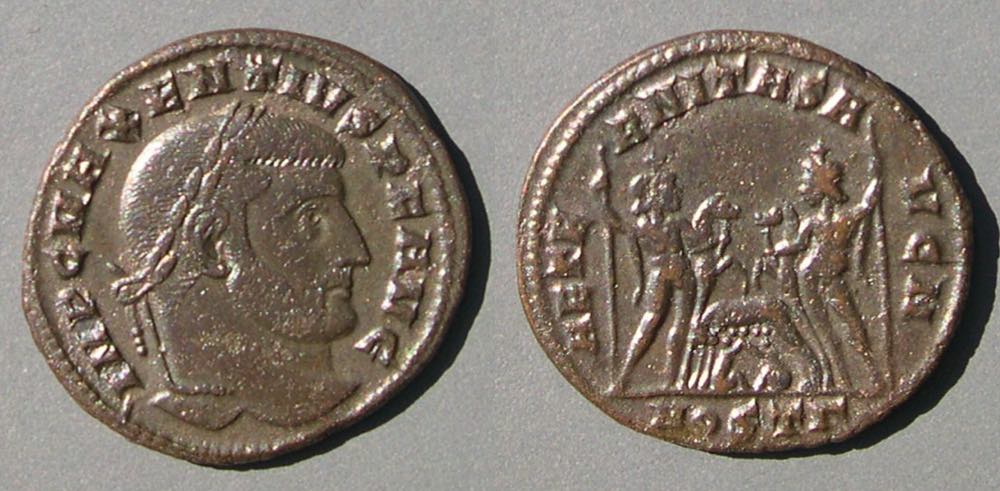 Maxentius, struck middle to late 309
Maxentius, struck middle to late 309
at Ostia, one of his mints.
26 mm. 6.26 grams.
IMP C MAXENTIVS PF AVG
AETERNITAS AVG N
"Our eternal Augustus"
The Dioscuri (distinguished by the stars at the top of their heads) standing, holding long staffs and facing each other and holding horses with wolf and twins between.
MOSTΓ
RIC Ostia 16.
 Maxentius
Maxentius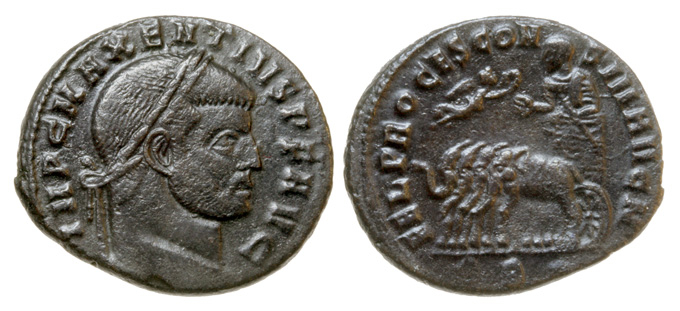 Maxentius
MaxentiusMaximian had been Augustus in the First Tetrarchy and was forced to retire in 305 by Diocletian. (His retirement issues are here.) When Maxentius usurped power in Rome in October 306, Maximian soon joined him and began his so-called "second reign." A large majority of coins of Maximian are of his first reign. Coins of his second reign are identified by reverses shared with other rulers who are known to be ruling after the Second Tetrarchy.
 Maximian, second reign.
Maximian, second reign.
Struck autum 307 - c. 309/310
25 mm. 7.35 grams.
IMP C MAXIMIANVS PF AVG
CONSERV VRBS SVAE
AQP
RIC VI Aquileia 121b.
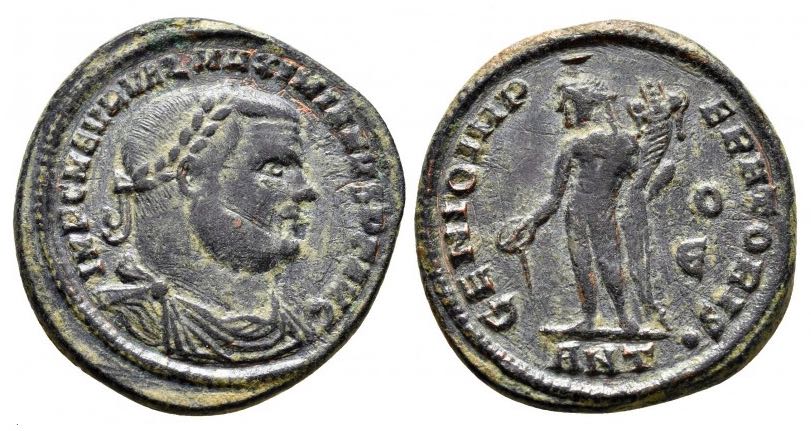 Maximian, third reign.
Maximian, third reign.Licinius was appointed Augustus by the Conference at Carnuntum in late 308. In 308 the west had three rulers all claiming the title of Augustus--Constantine, Maxentius, and Maximian. Galerius called the Conference at Carnuntum (with Galerius, Maximian, and Diocletian attending) to determine who should rule where and with what title. The results were that Maximian was told to retire again. Maxentius was declared a "public enemy," and Constantine was supposed to drop back down to Caesar, and a new man, Licinius, become Augustus without ever having been Caesar. Constantine recognized Licinius as an Augustus, but continued to mint for himself as Augustus too. So, instead of reducing the number of claimants to the title of western Augustus, Carnuntum actually added one to make four! (However, as we saw from the previous coin, western mints did not mint for Maximian after Licinius was elevated.)
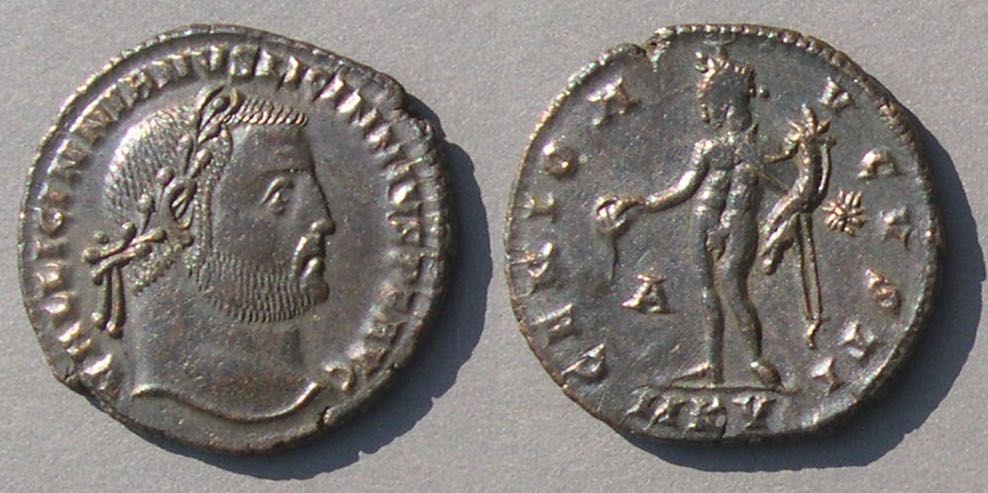 Licinius, 308-324
Licinius, 308-324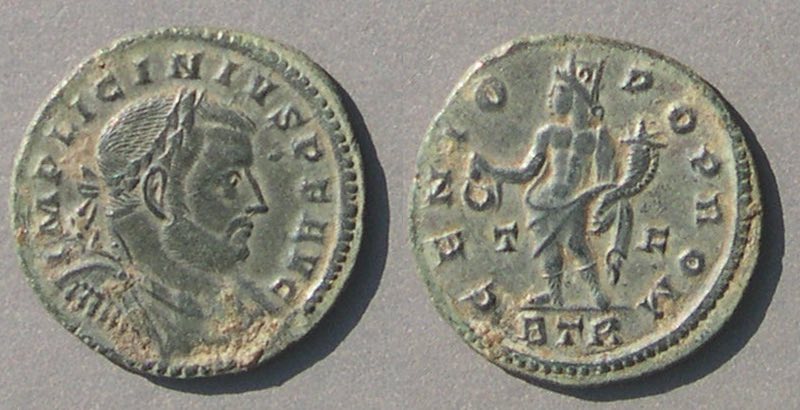

Notes for collectors: Coins of Constantine are extremely common--the most common of all the Roman rulers. He reigned thirty years as Augustus and only one year as Caesar, so his coins as Caesar are less common and carry a substantial premium. His coins as FIL AVGG an even greater premium. Here is a table with frequencies.
| Ruler | Title | Frequency |
| Constantine | Caesar Augustus FIL AVGG |
common, with a premium extremely common scarce, with a large premium |
| Galerius | Caesar Augustus |
very common |
| Maximinus II | Caesar Augustus FIL AVGG |
very common common scarce, with a large premium |
| Severus II | Caesar Augustus |
common |
| Maxentius | Princips Caesar Augustus |
very rare very rare common, with many types |
| Maximian | first reign second reign |
very common common |
| Licinius | Augustus | very common |
| Galeria Valeria | Augusta | common |
| Crispus | Caesar | very common |
| Constantine II | Caesar Augustus |
very common scarce |
| Licinius II | Augustus | very common |
| Romulus | DIVO | rare |
| Alexander of Carthage (308-310) |
Augustus | very rare |
| Valens (316-317) | Augustus | extremely rare |
| Martinian (324) | Augustus | extremely rare |
Other Romans on Coins.
Galeria Valeria was a daughter of Diocletian. She was given to Galerius is marriage when he became Caesar in 293 and coins were later minted for her at all the mints in the east, from Siscia to Alexandria, but apparently not until after the Conference at Carnuntum in late 308.
 Galeria Valeria
Galeria Valeria
25 mm. 6.21 grams
GAL VALERIA AVG
VENERI VICTRICI
✳ A
•SM•SD•
RIC VI Serdica 41 "Late 307-8" (That may be wrong. The other mints all have her coins beginning "late 308" or "Dec. 308" as if the Conference at Carnuntum brought her into the picture.)
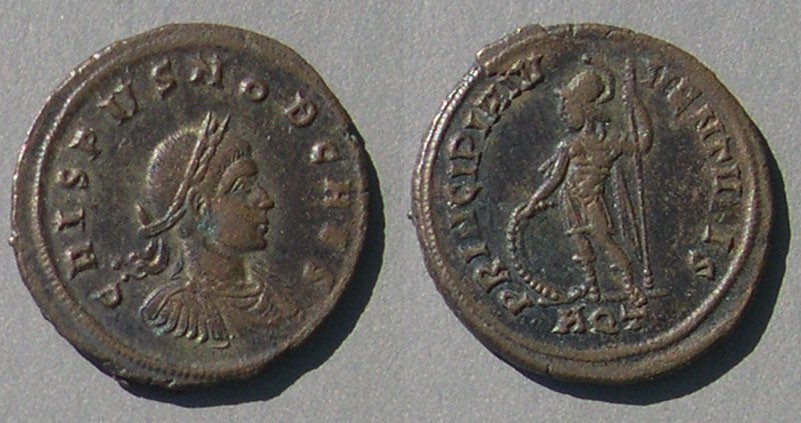 Crispus, Caesar 317-326.
Crispus, Caesar 317-326. Constantine II, "Constantine Junior" on the coin.
Constantine II, "Constantine Junior" on the coin. Licinius II, "Licinius Junior" on the coin.
Licinius II, "Licinius Junior" on the coin. 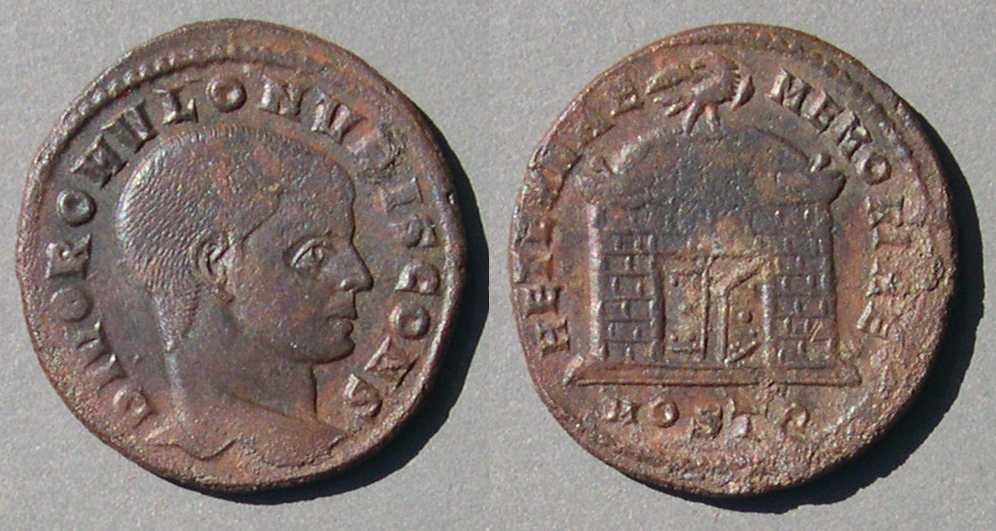 Romulus, d. 309.
Romulus, d. 309.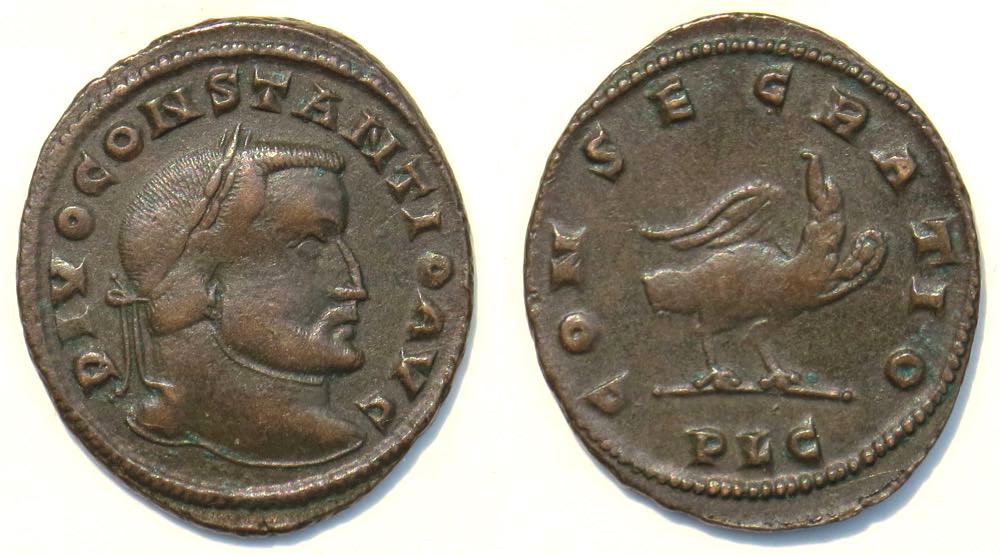
 DIVO CLAVDIO OPTIMO IMP
DIVO CLAVDIO OPTIMO IMPHistory. The sequence of events. The events that had a significant impact on the coinage are listed next. The end of the Second Tetrarchy with the death of Constantius begins the period of this page.
| Second Tetrachy | west | east |
| Augustus | Constantius | Galerius |
| Caesar | Severus II | Maximinus I |
• Constantine was acclaimed emperor by the army (surely prearranged by Constantius) when Constantius died July 25, 306. He minted coins as Caesar.
• Severus II, Caesar in the west, became Augustus in the west as expected in a tetrarchal system and approved by Galerius (the remaining, eastern, Augustus). There seems to have been some time lapse because there are issues (at Trier and Siscia) with both Severus and Constantine as Caesars. (Discussed on the page about dating)
• Maxentius, son of Maximian, seized power in Rome October 28, 306 when Severus was away in the north.
• Maximian came out of retirement to join him in November. He resumed the title Augustus and began his "second reign."
• Maxentius (early[?] 307) took the title Augustus (There are issues with Maxentius as Augustus and Constantine as Caesar)
• Maxentius and his father Maximian had a falling out when Maximian tried, and failed, to get the army at Rome to follow him instead of Maxentius. Maximian fled to the court of Constantine at Trier.
• Severus II was defeated in Spring 307 while attempting to retake Rome which was in his territory.
• Constantine, who was already married and had a son, Crispus, divorced his wife to make a dynastic marriage to Fausta (March 307), daughter of Maximian and sister of Maxentius, thus cementing the support of the elder statesman Maximian, while the alliance freed up Maximian and Maxentius to oppose Galerius's attempt to retake Rome. (Coins in the name of Fausta are common, but not minted until much later, after the fall of Licinius.) Constantine assumed the title Augustus with the authority of Maximian but without the approval of Galerius. Constantine's elevation to Augustus was as expected in a tetrarchal system because the Caesar becomes Augustus when the Augustus (Severus II) dies. Constantine did not pick a Caesar; there were already too many rulers in the west. At the time, Maxentius and Maximian were also claiming the title Augustus in the west.
• Alexander of Carthage rebeled against Maxentius in 308, issued rare coins, and was defeated in 310.
• Galerius, eastern Augustus, called a Conference at Carnuntum (25 miles east of Vienna on the Danube) in November 308 to straighten out who would be ruling where in the west, with Galerius and Maximian attending and the retired Diocletian attending to lend his authority. Diocletian had been seriously ill and no longer was the strong man he had been. The conference was dominated by Galerius. The decisions of the Conference were that Constantine should go back to being Caesar and a new man, Licinius, would become western Augustus with his territory being Pannonia until Italy and Africa could be recovered from Maxentius. Also, Maximian was required to retire (again. He went to Constantine's court until executed in 310 for plotting) and Maxentius was declared a "public enemy." This merely complicated matters because Constantine and Maxentius did not step down (Why would they?) and the eastern Caesar Maximinus II was offended that the new man Licinius would get the title Augustus, leapfrogging him.
• Galeria Valeria, daughter of Diocletian and wife of Galerius since 293, was added to the coinage, 308-310.
• Galerius invented and awarded a new title to both Constantine and Maximinus II, FIL AVGG, sons of the Augusti. Neither of them minted coins with that title for himself, but Galerius used it for both of them 308-310 and Maximinus used it for Constantine.
• Romulus, the very young son of Maxentius, died in 309. Maxentius minted DIVO pieces for him, late 309-312.
• Maximinus II had his army promote him to Augustus in 310.
• Maximinus II and Constantine were acknowledged as augusti by Galerius (as INVictus AVG? Maybe Maximinus II first?)
• Galerius dies from a terminal illness, beginning of May, 311. Maximinus II takes much of his territory.
• Maximinus II mints coins for Galerius as DIVO which include his (Maximinus') name with title FIL AVG and Licinius mints coins for Galerius as DIVO.
• Maxentius coined DIVO coins c. 310-311 for Maximian, Constantius, and Galerius (for Galerius after he died in May 311).
• Maxentius was killed at the Battle of the Milvian Bridge against Constantine, Oct. 28, 312.
• War between Licinius and Maximinus II resulted in the death of Maximinus II, April 313.
• Licinius inherited the entire east. So, from 313-317 only Constantine and Licinius are rulers. (In 317 they promoted their sons to Caesar.)
• Valerius Valens was made co-emperor by Licinius autumn-late 316 during the first Civil War between Licinius and Constantine. Constantine overran the territory of Valens and he was executed in 317.
• The Civil War lead to a truce in which Crispus, Constantine II, and Licinius II were made Caesars in 317
• Martinian was made co-emperor late summer 324 by Licinius during the second Civil War with Constantine.
• Licinius was defeated and forced to retire in autumn 324. Licinius and his son and Martinian were all executed in 325.
• Constantine became sole Augustus in 324 with his sons Crispus and Constantine II as Caesars.
This is the time period in which Christianity went from a persecuted religion to a permitted religion to the dominant religion. There is almost no indication on coins of this period of this monumental struggle. Christianity and Roman coins are discussed at "Christian Symbols on Roman Coins."
How coins reflect events.
Issues. An "issue" is a group of coins presumed to be produced at the same mint and during the same time period because they have the same mint marks (below the ground line on the reverse, i.e. "in exergue") and control marks (in the field). Sometimes an issue is subdivided by officina number (e.g. A, B, Γ, Δ). One issue may have different officina numbers and different legends for different rulers. Mints frequently changed mintmarks and control marks, so two coins with the same mint and control marks (not counting the officina number) must have been minted at almost the same time.
The next two coins are from the same issue. Note how they have the same mintmark (ALE) and field marks (K to the left and A over P on the right).
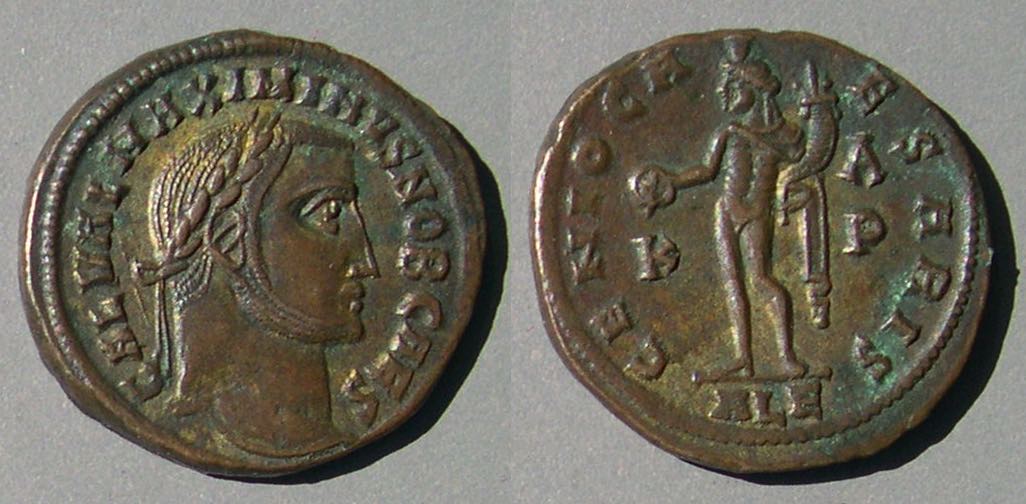

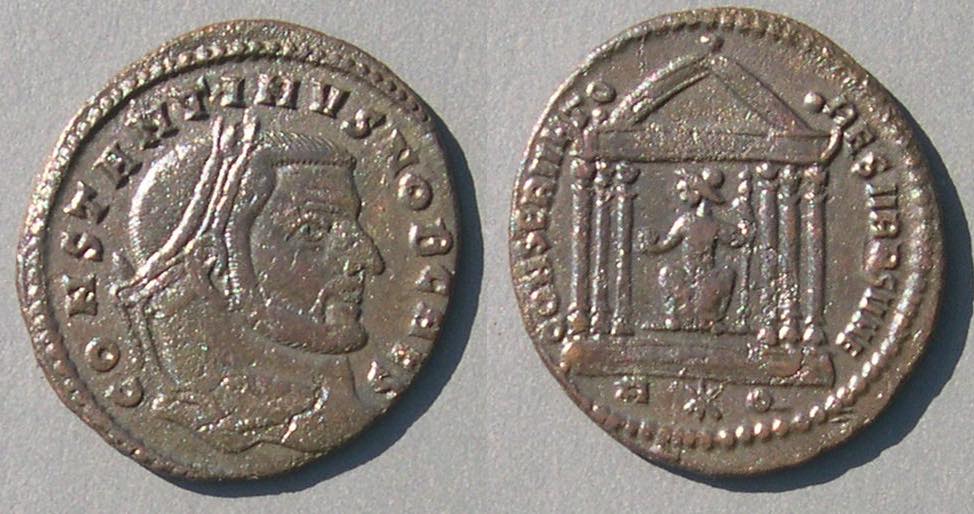 Constantine as Caesar, July 306-July 307
Constantine as Caesar, July 306-July 307The End
Go to a page of links to related web pages.
Go to the Table of Contents for this entire educational site.